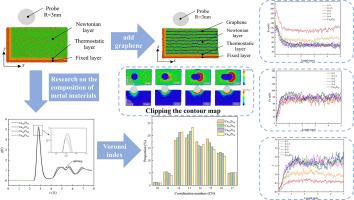金属玻璃/石墨烯复合材料划痕行为的分子动力学研究:石墨烯和探针的作用
IF 5.1
3区 材料科学
Q2 MATERIALS SCIENCE, COATINGS & FILMS
引用次数: 0
摘要
金属玻璃(mg)具有高强度、弹性和耐腐蚀性;然而,由于剪切带的萌生和扩展,其有限的延展性和较差的耐磨性阻碍了其更广泛的工程应用。为了解决这些问题,石墨烯层被引入作为增强相,形成MG/石墨烯纳米层状复合材料。分子动力学模拟表明,石墨烯层有效地阻止了剪切带的传播,并通过产生横向传播的剪切转变区来增强划痕性能。当石墨烯层间距为1 ~ 1.5 nm时,其承载能力增强,摩擦系数降低。对于石墨烯间距为1 nm的MG/石墨烯/MG-1,平均摩擦系数降至0.67,而Cu50Zr50的平均摩擦系数为1.69,降低了60%。在更大的划痕深度下,降低更为明显,系数降至0.49,比纯MG降低了近71.7%。与锥形探针相比,球形探针的法向载荷增加了两倍以上,摩擦系数降低了约30%,摩擦性能得到了显著改善。揭示了MG/石墨烯复合材料的双重增强机制——层间滑动和剪切转变区(STZ)调节,并进一步证明了石墨烯缓冲了塑性变形的速度敏感性。这些发现提供了超越先前MD研究的新的原子观点,并建立了对纳米尺度摩擦学增强的更全面的理解。本文章由计算机程序翻译,如有差异,请以英文原文为准。

Molecular dynamics study of scratch behaviors in metallic glass/graphene composites: Role of graphene and probe
Metallic glasses (MGs) exhibit high strength, elasticity, and corrosion resistance; however, their limited ductility and poor wear resistance caused by the initiation and propagation of shear bands hinder their wider engineering applications. To address these issues, graphene layers are introduced as a reinforcing phase to form MG/graphene nanolaminate composites. Molecular dynamics simulations reveal that graphene layers effectively impede the propagation of shear bands and enhance the scratch properties by generating shear transformation zones that propagate laterally. When the graphene interlayer spacing is 1–1.5 nm, the load-bearing capacity is enhanced and the friction coefficient decreases. For MG/graphene/MG-1 with graphene interlayer spacing of 1 nm, the average friction coefficient is reduced to 0.67 compared with 1.69 for Cu50Zr50, corresponding to a 60 % decrease. At greater scratch depths, the reduction is even more pronounced, with the coefficient dropping to 0.49, nearly 71.7 % lower than that of the pure MG. Compared to the conical probe, the spherical probe increases the normal load by more than twice and decreases the friction coefficient by about 30 %, demonstrating a significant improvement in frictional performance. It reveals dual reinforcement mechanisms in MG/graphene composites—interlayer sliding and Shear Transformation Zone (STZ) regulation—and further demonstrates that graphene buffers the speed sensitivity of plastic deformation. These findings provide new atomistic insights beyond previous MD studies and establish a more comprehensive understanding of nanoscale tribological enhancement.
求助全文
通过发布文献求助,成功后即可免费获取论文全文。
去求助
来源期刊

Diamond and Related Materials
工程技术-材料科学:综合
CiteScore
6.00
自引率
14.60%
发文量
702
审稿时长
2.1 months
期刊介绍:
DRM is a leading international journal that publishes new fundamental and applied research on all forms of diamond, the integration of diamond with other advanced materials and development of technologies exploiting diamond. The synthesis, characterization and processing of single crystal diamond, polycrystalline films, nanodiamond powders and heterostructures with other advanced materials are encouraged topics for technical and review articles. In addition to diamond, the journal publishes manuscripts on the synthesis, characterization and application of other related materials including diamond-like carbons, carbon nanotubes, graphene, and boron and carbon nitrides. Articles are sought on the chemical functionalization of diamond and related materials as well as their use in electrochemistry, energy storage and conversion, chemical and biological sensing, imaging, thermal management, photonic and quantum applications, electron emission and electronic devices.
The International Conference on Diamond and Carbon Materials has evolved into the largest and most well attended forum in the field of diamond, providing a forum to showcase the latest results in the science and technology of diamond and other carbon materials such as carbon nanotubes, graphene, and diamond-like carbon. Run annually in association with Diamond and Related Materials the conference provides junior and established researchers the opportunity to exchange the latest results ranging from fundamental physical and chemical concepts to applied research focusing on the next generation carbon-based devices.
 求助内容:
求助内容: 应助结果提醒方式:
应助结果提醒方式:


